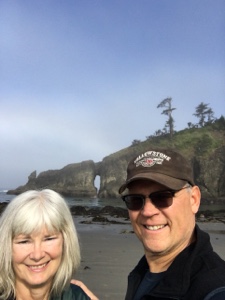"There is a view, when the morning mists peel off the harbor, where the steamers tie up, of the Houses of Parliament on one hand, and a huge hotel on the other, which is an example of cunningly fitted-in waterfronts and facades worth a very long journey," said Rudyard Kipling describing a 1908 visit to Victoria, the provincial capital of British Columbia.
Tim and I decided to add a smidgen of international travel to our Pacific Northwest trip so we booked walk-on tickets for the 90-minute ferry ride across the Strait of Juan de Fuca to this city so admired by Kipling. Opting for the earliest departure possible, the 8:15 a.m. ferry, we tried to see as much of the British-flavored city as possible before we needed to be back at the dock at 3:00 p.m.
Therefore, our visit was cursory, but armed with a copy of Frommers walking tour, we did our best to do the city justice.
I didn't take as many photos as I would have liked--I was too busy try to orient ourselves to the route, not to mention, my desire not to walk head-on into a streetlight or worse still, a passing vehicle--but perhaps the lack of photos is a good thing since I have plenty of wordy prose with which to praise this pretty place.
"Welcome to Victoria" in glowing, living color greeted us as the ferry docked at the Inner Harbor. Petunias planted in letter form were just one example of the floral window boxes and hanging baskets that gussied up the town like a string of diamonds above a dowager's decolletage.
 |
| The Fairmont Empress |
The huge hotel Kipling mentioned is the Fairmont Empress, built between 1904 and 1908 as the terminus hotel for the Canadian-Pacific steamship line. I could just imagine women in lacy afternoon gowns partaking of tea in the Lobby Lounge, an activity that still takes place today, although in much less formal attire.
 |
| Craigdarroch Castle |
One of Canada's finest stately mansions, according to my Lonely Planet's travel guide, is Craigdarroch Castle, once the home of the Vancouver Island coal and railroad capitalist, Robert Dunsmuir who built it in the late 1880s and died just before it was completed.
Only his widow Joan and three of their youngest children lived this mansion where sunlight streams through stained glass windows in almost every room.
 |
| Joan Dunsmuir, left; Robert Dunsmuir, right |
Dunsmuir's death stirred up strife in the family. Contrary to promises made to his two sons, he left his entire estate and business holdings to his wife. This was a blow to both James and Alex (then in their thirties) who had worked in the family business all their lives. Years later because of the estrangement, neither felt a compulsion to attend their mother's funeral.
Bastian Square, a public space where restaurants and street musicians beckon tourists, stands on the site of the Hudson Bay Company's original Fort Victoria. The fort, demolished in 1863, was established by the Company in 1843 as a depot for the northern Pacific trade. The Company's main headquarters, Fort Vancouver, was too far from the British Columbia interior and coast to serve fur trappers and traders efficiently. Moreover, once the international boundary was set at the 49th parallel, Fort Vancouver was no longer under British authority; thus, the need for Victoria's fort.
We hustled through Trounce Alley, where miners and sailors once visited ladies of the night. Now it's a gaslit pedestrian walkway lined with European-chic shops,
Then we hurried over to Victoria's Chinatown, second only to San Francisco as the oldest Chinese conclave in North America. Fan Tan Alley was originally a gambling district and undoubtedly a place where opium dens flourished. Tim and I squeezed through its narrow width, notably 35-inches in one spot, to view the small shops and take-out food establishments that do business there today.
 |
| The Parliament Building |
The Parliament Building, the province's legislature, is a dramatically handsome confection of turrets and domes with a statue of Queen Victoria standing before it, a fitting tribute to the sovereign for whom the city is named. There's a free, behind-the-scenes tour of the building, but we walked up to the kiosk at 2:10 p.m., too late to join it before our ferry's departure. Maybe some day we'll return. I hope so.



































































